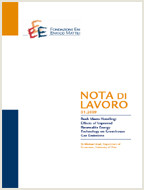Environmental Regulation and Competitiveness: Empirical Evidence on the Porter Hypothesis from European Manufacturing Sectors

01.10.2014
Yana Rubashkina, Marzio Galeotti, Elena Verdolini
Q50, Q52, Q55, Q58, O31
Environmental Regulation, Innovation, Productivity, Competitiveness, Porter Hypothesis
Climate Change and Sustainable Development
Carlo Carraro
This paper represents an empirical investigation of the “weak” and “strong” Porter Hypothesis (PH) focusing on the manufacturing sectors of European countries between 1997 and 2009. By and large, the literature has analyzed the impact of environmental regulation on innovation and on productivity generally in separate analyses and mostly focusing on the USA. The few existing studies focusing on Europe investigate the effect of environmental regulation either on green innovation or on performance indicators such as exports. We instead look at overall innovation and productivity impact that are the most relevant indicators for the “strong” PH. This approach allows us to account for potential opportunity costs of induced innovations. As a proxy of environmental policy
stringency we use pollution abatement and control expenditures (PACE), which represent one of the few indicators available at the sectoral level. We remedy upon its main drawback, that of potential endogeneity of PACE, by adopting an instrumental variable estimation approach. We find evidence of a positive impact of environmental regulation on the output of innovation activity, as proxied by patents, thus providing support in favor of the “weak” PH in line with most of the literature. On the other front, we find no evidence in favor or against the “strong” PH, as productivity appears to be unaffected by the degree of pollution control and abatement efforts.
***
Suggested citation: Yana Rubashkina, Marzio Galeotti, Elena Verdolini, Environmental regulation and competitiveness: Empirical evidence on the Porter Hypothesis from European manufacturing sectors, Energy Policy, Volume 83, August 2015, Pages 288-300, ISSN 0301-4215, http://dx.doi.org/10.1016/j.enpol.2015.02.014
